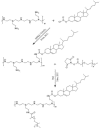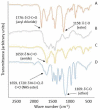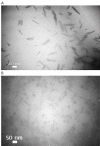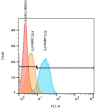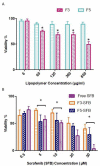Effect of PEGylation on assembly morphology and cellular uptake of poly ethyleneimine-cholesterol conjugates for delivery of sorafenib tosylate in hepatocellular carcinoma
- PMID: 30397579
- PMCID: PMC6209830
- DOI: 10.15171/bi.2018.27
Effect of PEGylation on assembly morphology and cellular uptake of poly ethyleneimine-cholesterol conjugates for delivery of sorafenib tosylate in hepatocellular carcinoma
Abstract
Introduction: Sorafenib (SFB) is an FDA-approved chemotherapeutic agent with a high partition coefficient (log P = 4.34) for monotherapy of hepatocellular carcinoma (HCC). The oral bioavailability is low and variable, so it was aimed to study the application of the polymeric nanoassembly of cholesterol conjugates of branched polyethyleneimine (PEI) for micellar solubilization of SFB and to investigate the impact of the polymer PEGylation on the physicochemical and cellular characteristics of the lipopolymeric dispersions. Methods: Successful synthesis of cholesterol-PEI lipopolymers, either native or PEGylated, was confirmed by FTIR, 1H-NMR, pyrene assay methods. The nanoassemblies were also characterized in terms of morphology, particle size distribution and zeta-potential by TEM and dynamic light scattering (DLS). The SFB loading was optimized using general factorial design. Finally, the effect of particle characteristics on cellular uptake and specific cytotoxicity was investigated by flow cytometry and MTT assay in HepG2 cells. Results: Transmission electron microscopy (TEM) showed that PEGylation of the lipopolymers reduces the size and changes the morphology of the nanoassembly from rod-like to spherical shape. However, PEGylation of the lipopolymer increased critical micelle concentration (CMC) and reduced the drug loading. Moreover, the particle shape changes from large rods to small spheres promoted the cellular uptake and SFB-related cytotoxicity. Conclusion: The combinatory effects of enhanced cellular uptake and reduced general cytotoxicity can present PEGylated PEI-cholesterol conjugates as a potential carrier for delivery of poorly soluble chemotherapeutic agents such as SFB in HCC that certainly requires further investigations in vitro and in vivo.
Keywords: Cholesterol; Hepatocellular carcinoma; Lipopolymer; PEGylation; Poly ethyleneimine; Polymeric micelles; Sorafenib tosylate.
Similar articles
-
Chemically crosslinked nanogels of PEGylated poly ethyleneimine (l-histidine substituted) synthesized via metal ion coordinated self-assembly for delivery of methotrexate: Cytocompatibility, cellular delivery and antitumor activity in resistant cells.Mater Sci Eng C Mater Biol Appl. 2016 May;62:897-907. doi: 10.1016/j.msec.2016.02.045. Epub 2016 Feb 19. Mater Sci Eng C Mater Biol Appl. 2016. PMID: 26952497
-
Novel branched poly(ethylenimine)-cholesterol water-soluble lipopolymers for gene delivery.Biomacromolecules. 2002 Nov-Dec;3(6):1197-207. doi: 10.1021/bm025563c. Biomacromolecules. 2002. PMID: 12425656
-
Synthesis of pectin-deoxycholic acid conjugate for targeted delivery of anticancer drugs in hepatocellular carcinoma.Int J Biol Macromol. 2019 Oct 15;139:665-677. doi: 10.1016/j.ijbiomac.2019.07.225. Epub 2019 Aug 1. Int J Biol Macromol. 2019. PMID: 31377298
-
Enhanced delivery of sorafenib with anti-GPC3 antibody-conjugated TPGS-b-PCL/Pluronic P123 polymeric nanoparticles for targeted therapy of hepatocellular carcinoma.Mater Sci Eng C Mater Biol Appl. 2018 Oct 1;91:395-403. doi: 10.1016/j.msec.2018.05.011. Epub 2018 May 4. Mater Sci Eng C Mater Biol Appl. 2018. PMID: 30033270
-
Micelle-like nanoassemblies based on polymer-drug conjugates as an emerging platform for drug delivery.Expert Opin Drug Deliv. 2012 Jul;9(7):805-22. doi: 10.1517/17425247.2012.689284. Epub 2012 May 19. Expert Opin Drug Deliv. 2012. PMID: 22607499 Review.
Cited by
-
Lipid based nanoparticles as a novel treatment modality for hepatocellular carcinoma: a comprehensive review on targeting and recent advances.J Nanobiotechnology. 2022 Mar 5;20(1):109. doi: 10.1186/s12951-022-01309-9. J Nanobiotechnology. 2022. PMID: 35248080 Free PMC article. Review.
-
Sorafenib-Based Drug Delivery Systems: Applications and Perspectives.Polymers (Basel). 2023 Jun 9;15(12):2638. doi: 10.3390/polym15122638. Polymers (Basel). 2023. PMID: 37376284 Free PMC article. Review.
-
Lipid metabolism of hepatocellular carcinoma impacts targeted therapy and immunotherapy.World J Gastrointest Oncol. 2023 Apr 15;15(4):617-631. doi: 10.4251/wjgo.v15.i4.617. World J Gastrointest Oncol. 2023. PMID: 37123054 Free PMC article. Review.
-
Construction of NIR Light Controlled Micelles with Photothermal Conversion Property: Poly(poly(ethylene glycol)methyl ether methacrylate) (PPEGMA) as Hydrophilic Block and Ketocyanine Dye as NIR Photothermal Conversion Agent.Polymers (Basel). 2020 May 21;12(5):1181. doi: 10.3390/polym12051181. Polymers (Basel). 2020. PMID: 32455766 Free PMC article.
-
Polymeric Drug Delivery Systems Bearing Cholesterol Moieties: A Review.Polymers (Basel). 2020 Nov 6;12(11):2620. doi: 10.3390/polym12112620. Polymers (Basel). 2020. PMID: 33172152 Free PMC article. Review.
References
LinkOut - more resources
Full Text Sources

